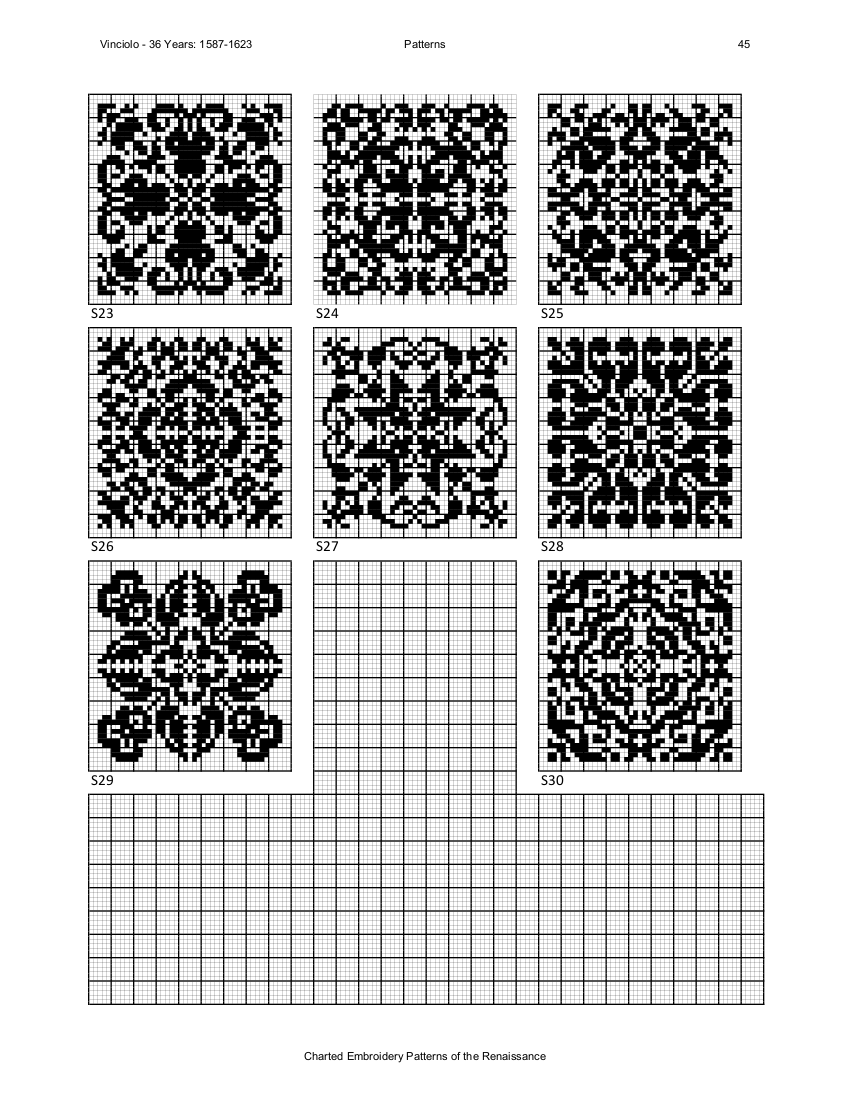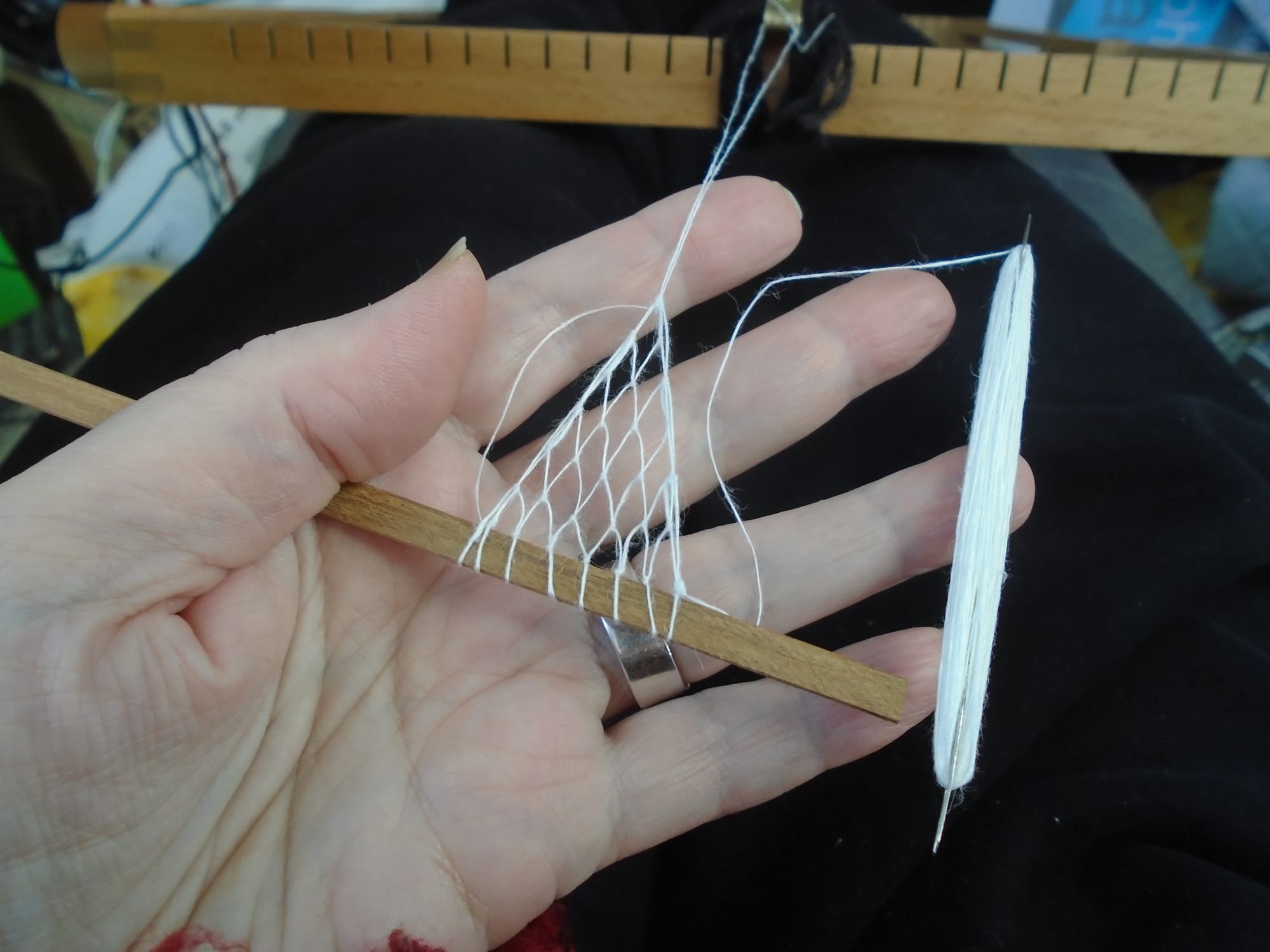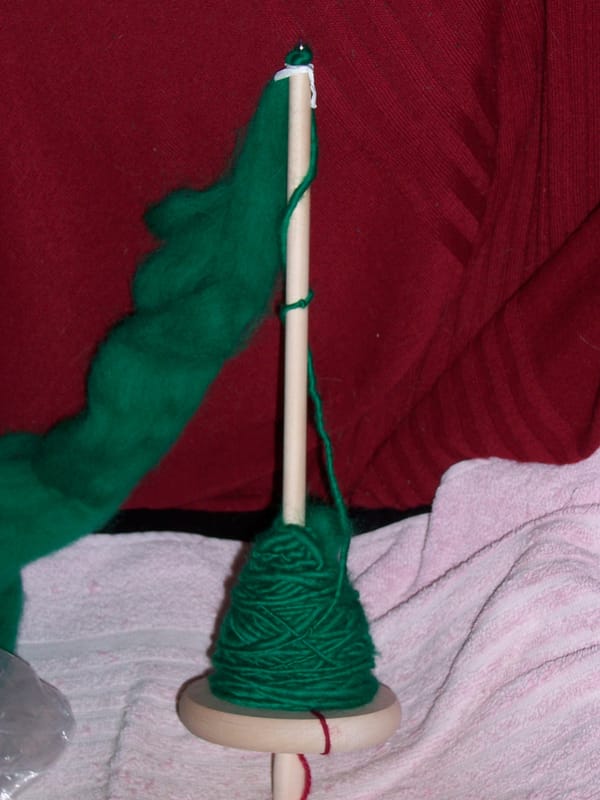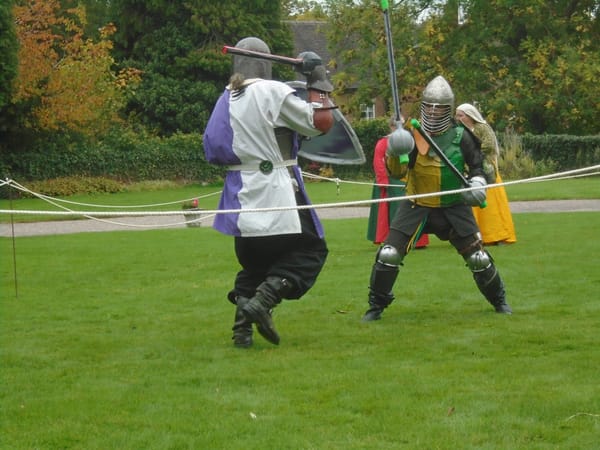Panel games

I really want to get my Easter class excited about netting and what can be done with it; so I plan to bring a few samples to show them. There will, obviously, be a string bag. There will be the stole (I'm not going to link any particular post here because it got mentioned in a few of them, but if you recall it's the one in the silver and white DK yarn that I started off on a headrope); there will be the spruce green shawl, which is much finer gauge; and, now that my very fine mesh sticks have finally arrived, there will be a piece of filet work... which, of course, was the original point of brushing up my dormant netting skills, but that particular shrub has branched off sideways in quite a few directions.

Getting hold of that mesh stick, incidentally, was an undertaking, and a very expensive one at that. Would you believe it cost me about £4.50? (It's not on its own, either. I have spares in case it breaks. After all, it's only about 1 mm thick.) I could not get stripwood small enough on Etsy, so I had to have it custom-cut. However, it is teak, which is one of the reasons it's so expensive; I didn't choose the wood but I'm pretty happy with it, because it won't warp easily, and given the fact that even here in East Anglia the British climate tends to be pretty damp, that's important. It doesn't matter so much for a larger, thicker strip of wood, but if this little thing was just your standard pine I suspect it would be all skew-whiff in no time. Still, I should never have to buy any more, and it means that finally I get to make netting I can use to work filet without looking ridiculous.
The thread, by the way, is fine linen which comes on an enormous cone. The gauge is pretty similar to regular sewing thread, on average, but it's less even; there are slightly thicker and thinner sections, though that isn't especially obvious. It's not like the jute twine, which is very variable in thickness (I think it adds to the rustic charm of the string bags, myself). However, of course, being linen, it's stiffer than sewing thread, which is one of the two reasons why I'm using it to make the netting. The other reason is that you can coax linen into any shape you want by dampening it - it needn't even be very much - and then arranging it into the desired shape and letting it dry. If you're making square-mesh netting, which notoriously tends to pull diagonally because of the way you make it, then that is an exceedingly useful characteristic, because when you start doing your filet embroidery you want all the lines to be absolutely perpendicular.
The next question was: what, exactly, was I going to embroider? I have only so much time before Easter, so it couldn't be anything large and complicated, but it did have to be interesting. Last year I spent quite a lot of time gathering all the patterns I could find from the Internet that could possibly be used for filet embroidery; most of them were actually either monochrome cross stitch or filet crochet patterns, which is an immediate cue for one of my... well, let's call them relevant digressions.
Filet crochet evolved as an imitation of filet embroidery. The thing is, it's not that filet embroidery is at all difficult; there's an art to it, true, but it actually isn't that hard to learn. I taught a friend in London the basic principles in about half an hour. But it is exceedingly slow, especially when you factor in the fact that you generally need to make your own net. Also, netting and filet are two different techniques, but to do filet you have to know how to do netting, unless you can source the net from elsewhere... which was never easy and is now pretty close to impossible. Filet crochet, however, uses treble crochet, which is exactly the same as for granny squares; it's the one thing anyone who can crochet at all can do. So it's very easy, it's a lot quicker, and effectively you make the net as you go rather than having to make it first using a different technique and only then filling in some of the squares. I will admit, I'm a purist. I'm not a great fan of filet crochet. But I don't think anyone ever is once they learn how to do the real thing (which has much cleaner lines); and it does have its place, even if only to enable people to practise the designs while they're still learning the techniques they need to do filet embroidery!
Anyway. Here am I, with a massive folder on my hard drive full of filet patterns, combing through them, and what I find is... nothing really works. Everything is either nice but too large and complicated, or (at least on its own) too simple to be really interesting. That cute penguin design would look adorable as part of a border, but on its own, honestly, it's kind of meh. Some of the alphabets are quite suitable, but then, what letter do I embroider?
And then I think... oh yes. I have Vinciolo.
Federico Vinciolo was a Renaissance lacemaker and a very prolific designer; and, in particular, he did a vast number of designs for filet work (which was, and still in some quarters is, considered to be a form of lace). They range from large and ambitious designs - hunting scenes, an anthropomorphic depiction of the four seasons, the Nativity, the Crucifixion (I think I might be inclined to leave out the haloes, but they were very much de rigeur in Vinciolo's day), and even a delightful calendar showing each month with its name and various putti engaged in activities appropriate to the month - to simple borders, panels, frames, and motifs. I had a number of Vinciolo's designs in my book on filet, which, like nearly everything else, disappeared in 2016; fortunately quite a lot of them turned up in a free e-book I found somewhere online. I forget exactly where, or I would link it for you. I no longer have the calendar design, but I think I have pretty much all the others that appeared in the book, plus many more. And, in particular, there is a huge number of square panels just under 45 x 45 meshes, which seems like a good size (it works out at a bit under 30 cm square at the gauge I'm making). The ones you see in the feature photo are just a few of them. I'm spoilt for choice! I shall just make a square about that size and then pick one of them. It occurs to me that it would be quite a fun project to make all the panels of that size in the book, then piece them together (maybe separated by tape woven from the same linen) to make a lacy tablecloth or bedcover. I need to resist that temptation; I already have more than enough to do.
Vinciolo, apparently, died around 1599. He didn't quite make it into the seventeenth century. But I would not be surprised if some of his designs make it into the twenty-seventh.




